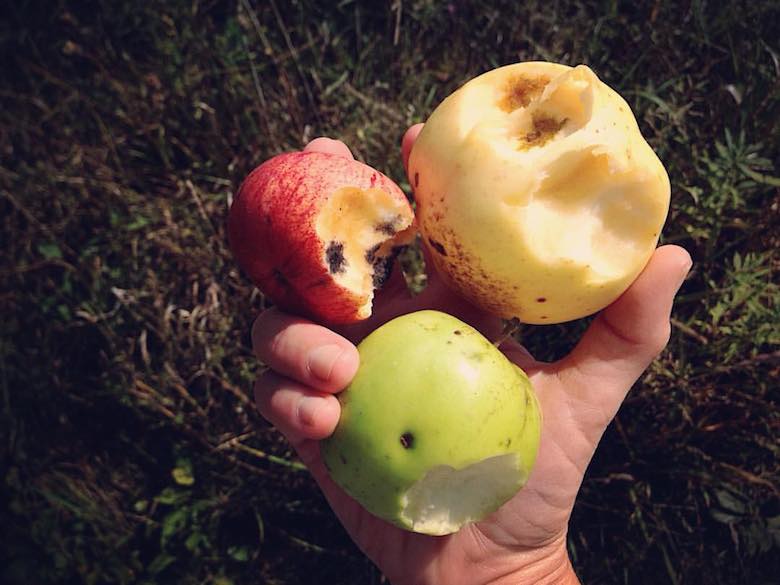https://www.instagram.com/p/BUXus4KgA1I/
On an afternoon stroll in Park Slope’s Green-Wood Cemetery, local resident and hard cider producer Jeremy Hammond caught sight of a lone apple amidst the underbrush. After biting into the fruit, he found its taste bittersweet—unpleasant from a snacking perspective, but ideal for cider making. Seeing no fruit-bearing trees in sight, Hammond darted up the hill that he guessed the apple had rolled down, and at the top of the hill, near the Samuel Morse memorial, he struck gold: A gargantuan forty-something-foot-tall tree was bearing the same type of apple as the one he found below, which he and his partner, Joy Doumis, would later use in their locavore cider project.
“It had interesting characteristics we’d look for in cider apple,” says Doumis about the Morse Memorial apple, which they’ve appropriately nicknamed “Morse Code,” and has a smoky profile like mezal. “When you bite into it, it’s got tannins like if you were to suck on teabag. I’ve never tasted an apple like this.”
When people visit Brooklyn’s Green-Wood Cemetery, they’re either coming to pay respect to their ancestors or enjoy a surprisingly quiet natural environment within the confines of the five boroughs. But for New York City’s Hammond and Doumis, the duo behind local cidery Proper Cider!, Green-Wood Cemetery’s administration has happily approved the gravesite to become their go-to supplier for interesting and rare apple varieties within Kings County. By fermenting cider from the apples of the cemetery and hosting tastings surrounding the product, the pair are also giving Green-Wood a second life as a park chockful of resources for artisanal food projects.
https://www.instagram.com/p/9baW_QNcZd/
For over a decade, Doumis and Hammond have been part of New York State’s growing hard cider scene, fermenting with batches of apples from upstate orchards in their backyard. Green-Wood Cemetery, however, is new ground for their cider project. During the Temperance and Prohibition movements throughout the 19th century, thousands of farmers and cider makers around the nation chopped down cider-worthy apple trees, but Green-Wood Cemetery’s were among those spared due to its main use for burying the deceased. Since Hammond’s discovery near the Morse Memorial in 2015, he and Doumis have found dozens of other apple varieties throughout Green-Wood’s 478-acre cemetery that they’ve used for cider blends. In addition to the unidentifiable “Morse Code,” varieties used by Hammond and Doumis are the Baldwin, which is an American heirloom apple first discovered in 18th century and popular for cider-making Pre-Temperance, as well as a variety of trees bearing tart Granny Smith and crab apples, which they also use for cider blends.
Doumis and Hammond admittedly aren’t the first artisanal experiment in Green-Wood Cemetery. After receiving accreditation as an arboretum in 2015, Green-Wood set up its own apiary. According to Joe Charap, the director of horticulture for Green-Wood Cemetery in Brooklyn, these projects like the Proper Cider! and workshops, as well as the Green-Wood apiary, help entice residents to engage with this quasi-urban escape.
“[Green-Wood] is embracing its role as this very green space in an urban environment,” says Charap. “There are many avenues for research, community involvement and we’re working with our neighbors on projects where they experience nature in an interactive way.”
https://www.instagram.com/p/BUISgEdgtyv/
Doumis and Hammond are furthering their efforts in cementing a symbiotic relationship with their supplier looking beyond the bottle in their collaborative efforts with Green-Wood. Many of the trees, Doumis explains, are unidentified, and some might be varieties thought to be lost to the Prohibition apple tree massacre. Recently, they’ve teamed up with John Bunker, one of the foremost apple, who they plan to do a walk-around with this July to see if they can identify any long-lost varieties like “Morse Code.”
“It’s interesting to learn that these trees are as old as they look and hung in there because of their unique location,” says Doumis. “We’re educating people about horticultural side of Green-Wood, and also cider!.”



